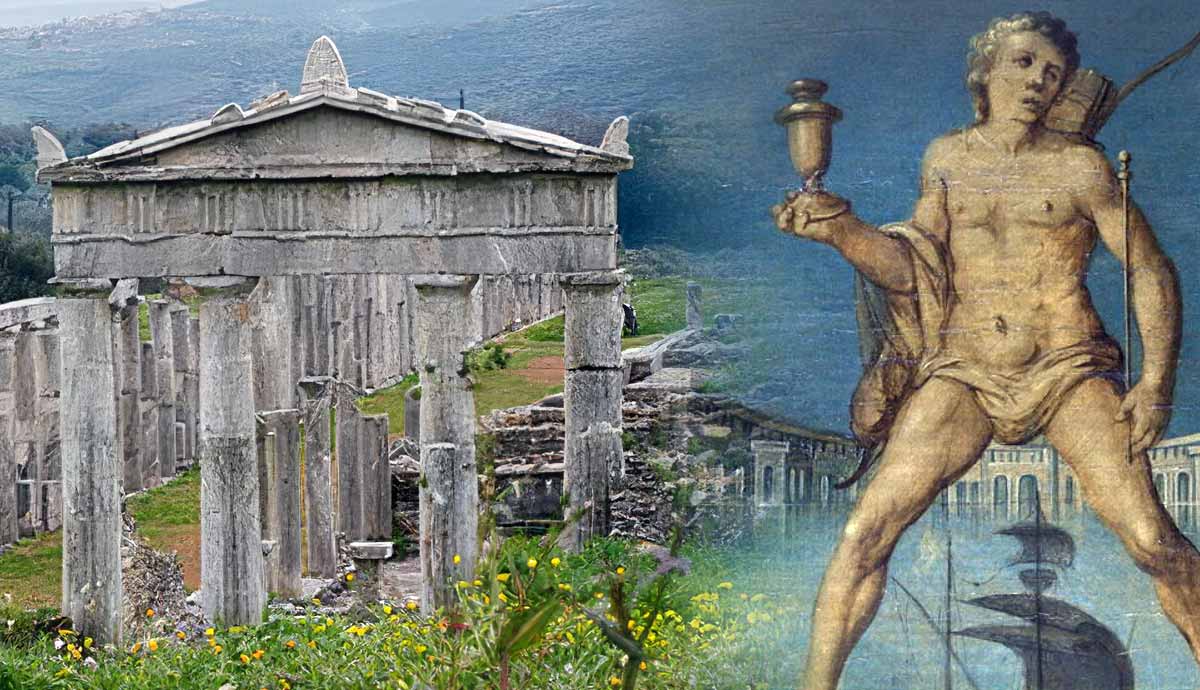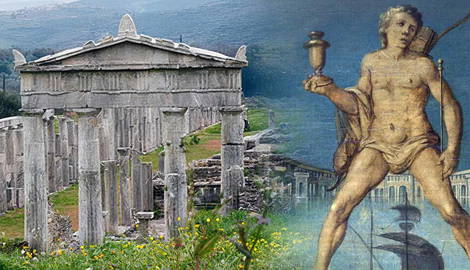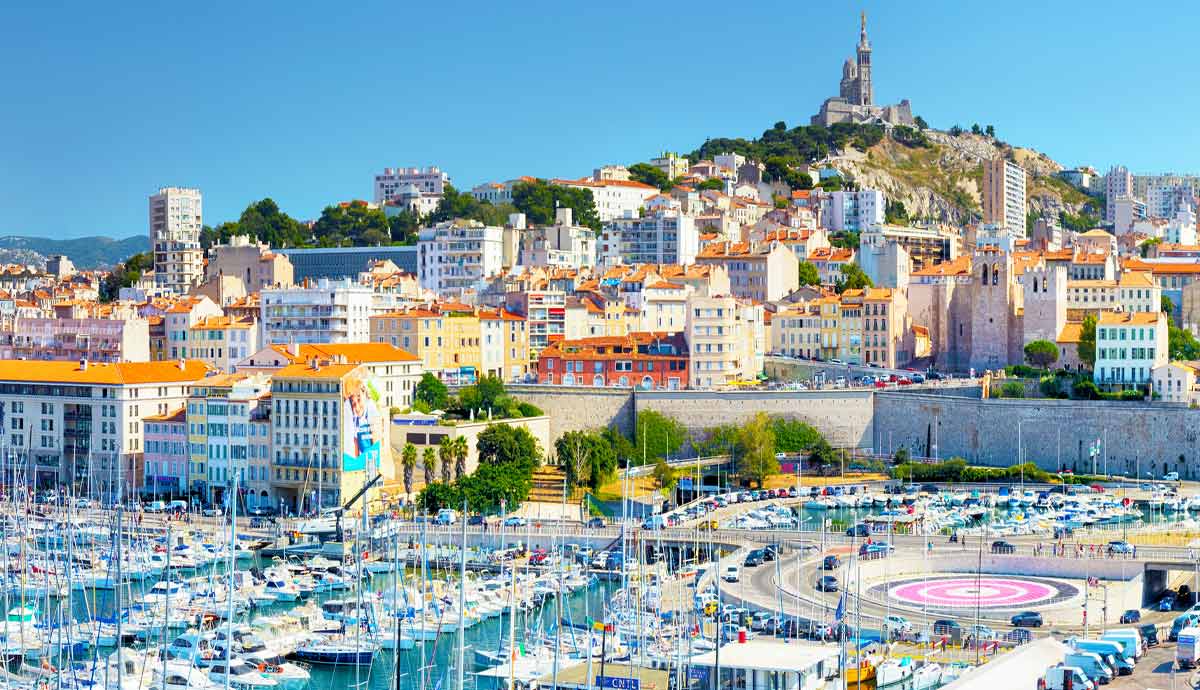
Ancient Greece was never a centralized and united country. It was a network of dispersed city-states, called polis or poleis in the plural, organized into kingdoms and federations. The most famous of these cities, Athens and Sparta, were merely the biggest players in a complex and dynamic world. Modern studies have counted at least 1,035 poleis during the Archaic and Classical eras and around 800 in 400 BCE (Hansen & Nielsen, 2004, 53). Many were tiny by modern standards but considered themselves autonomous, self-governing, and fiercely protected their independence. The decentralized nature of ancient Greece was key to its political and cultural development. In this article, we will meet four of Greece’s smaller poleis that had a big impact on history.
Eretria

A visit to Eretria gives you a glimpse into the reality of a polis. As you approach the coast of central Evia by ferry, you can see in a single glance the entirety of Eretria from the harbor up to the acropolis. The site is easily walkable in a few hours. Yet, this small slice of Greece was one of the most important places in the Mediterranean for hundreds of years. It was conquered by and resisted empires and contributed to the development and spread of the Greek alphabet.
When Greece was going through its Dark Ages following the collapse of Mycenaean civilization in the 12th century BCE, Eretria and its neighbor and rival Chalkis emerged as centers of the Aegean world. While much of Greece was still in an era of decline, the inhabitants of the long and narrow island of Euboea placed themselves at the heart of trade and communication between the east and west of the Mediterranean. Euboians pioneered the colonization phase of Greek history, which saw settlements founded in the Levant, Northern Aegean, Sicily, and Italy. Many of these were trading posts, but culture and innovation also spread. Their contacts with the Phoenicians in the east made the Euboians good candidates for adapting the Phoenician alphabet to the Greek language (Walker, 2004, 145). Their Western contacts spread this to Italy, beginning the long process that ultimately led to the creation of the Latin alphabet and its modern descendants.

Once the fog of prehistory starts to lift, the Eretrians are one of the first Greek communities we meet. They engaged in, and seemingly lost, one of the first recorded wars, the Lelantine War, against their neighbor Chalkis. This did not hold the Eretrians down for long. The late 6th and early 5th centuries saw them closely connected to Athens, perhaps joining that city as an early democracy. They certainly did join the Athenians in the ill-fated attempt to help the Greeks of Asia Minor revolt from Persia. That entangled the Eretrians in a war with the most powerful empire of their day, leading to the destruction of the city by the Persians on their way to Marathon in 490 BCE.
Again, the Eretrians recovered from this disaster and fought the Persians alongside other Greeks in 480/79 BCE. Eretria’s relations with a shifting array of great powers shaped its history in the Classical and Hellenistic eras. They were alternatively allied or subjugated to the Athenians but led key revolts against them, particularly in 411 BCE. Along with the other poleis on Euboia, they occasionally experimented with federalism, but gradually, Eritrea’s importance diminished as Chalkis became a much fought-over strategic location.

Eretria and its surrounding territory continue to be archaeologically significant. The city’s site has produced beautiful 4th-century BCE mosaics, while its rural sanctuary of Artemis has recently been rediscovered and is one of the most promising new archaeological sites.
Plateia

Plataea, tucked away in the southwest corner of the central region of Boeotia, was, by any measure, a minor city. Its total estimated territory was around 170 km2, and it was home to only a few thousand citizens (Hansen, 2004, 450). Despite this, Plateia played a major role in not one but two of antiquity’s greatest conflicts.
As a Boiotian town, the Plataians’ main relationship was always going to be with Thebes, which sat in the center of Boeotia and often dominated the region. When Plataia emerged in the historical record in the late 5th century BCE, we see a small community defending its own identity and autonomy against Thebes (Herodotus, 6.108). If Plataea and Thebes had an antagonistic relationship, this naturally improved the Plataians’ connection with its other big neighbor, Athens. The alliance with Athens set the course of Plataian history for two centuries.
Such was the bond between the two cities that the Plataians were the only people to stand with Athens at the battle of Marathon in 490 BCE. Having faced down the mighty Persian Empire once, the Plataians did so again when they returned ten years later. While much of Boeotia went over to the Persians, the Plataians resisted and saw their land occupied as a result. The decisive battle of the Persian Wars in 479 BCE took place on their land and came to be known as the Battle of Plataea. As the site of the liberation of Greece, those Greeks who resisted promised to guarantee Plataia’s future freedom. But this would turn out to be too idealistic a dream (Thucydides, 2.71.2).
Having hosted the end of one era-defining conflict, Plataia was tragically caught up in the beginning of another in the 420s BCE. With the Peloponnesian War between the Athenians and Spartans brewing, Thebes, a Spartan ally, once again tried to assert control over Plataea. The Theban attack was initially unsuccessful, but it helped trigger a 27-year war and a catastrophe for the Plataians. The failed Theban attack drew in the Spartans, who besieged the city between 429-427 BCE. A Plataian garrison, with some Athenian assistance, bravely held on, but was forced to surrender. Upon handing themselves over to the Spartans, the garrison was cruelly executed, and Plataea razed to the ground.

The Plataians spent a large part of the next century in exile. Their city was briefly restored after 386 BCE, but was again attacked and destroyed by the Thebans in 373 BCE. Only the defeat of Thebes by the Macedonians in 338 BCE saw a stable restoration of Plataea. It is hardly surprising that the Plataians joined in the destruction of Thebes in 335 BCE.
Despite its small size and violent history, Plataia developed into a distinguished corner of Greece. Not only was the memory of the liberation from the Persians kept alive for centuries, but Plateia played a role in maintaining a Boiotian identity by hosting a regular pan-Boeotian festival (Pausanias, 9.3.4), demonstrating the complexity of local Greek identities. Nor was Plataea lacking culturally as the tiny city boasted works by Praxiteles, Pheidas, and Polygnotos, some of ancient Greece’s finest artists (Pausanias, 9.2-4).
Rhodes

Even small and medium-sized islands often hosted multiple poleis. This was true of Rhodes, which was divided into three communities until the late 5th century BCE. Things changed in 408 BCE, when the three poleis collectively formed a new city in the island’s northeast corner. This new city of Rhodes, with its five harbors, was founded in the perfect location to take advantage of the island’s strategic position on Aegean and Mediterranean trade routes (Berthold, 2009, 22).
Rhodes spent much of the Classical era alternating between alliances or subjugation to powers such as Persia, Athens and Sparta. But gradually, the city and its fleet became more influential as the Hellenistic era dawned. By the time the wars of Alexander the Great’s successors were underway, the Rhodians were said to be a wealthy naval power (Diodorus, 20.81). They sought their own autonomous position in a dangerous world by being friendly but not overly close to all the rival generals while increasing trade by sweeping the seas of pirates.
While the Rhodians may have tried to stay out of the wars raging around them, in 305 BCE, their island became the stage for one of the most famous sieges of antiquity. The warlords Antigonus and his son Demetrius judged that the Rhodians were too friendly with their rival Ptolemy. The 40,000 troops and 200 ships that Demetrius brought before the walls of Rhodes dwarfed the 7,000 or so defenders (Wheatley & Dunn, 2020, 186). Though outnumbered, the Rhodians skillfully defended their city. With the siege dragging on into 304 BCE, Demetrius’ next move made his name. He ordered the construction of siege engines of unprecedented size, 44 meters high, and moved by 3,400 people, earning the nickname Demetrius Poliorcetes (the besieger). Still, the Rhodians held on, but gradually, Demetrius was grinding them down. Just before the city fell, a truce was agreed upon, which allowed the Rhodians to maintain their autonomy but made some concessions.
The Rhodians may not have defeated Demetrius, but they survived, and for that, they thanked their patron deity, Helios. Their offering to Helios became one of the seven wonders of the ancient world: the Colossus of Rhodes. This 30-meter-high statue of Helios placed at the entrance of one of Rhodes’ harbors was by far the largest sculpture made in antiquity. The Colossus only stood for a few decades before being toppled by an earthquake in 226 BCE.

During the 3rd and 2nd centuries BCE, Rhodes became a major Aegean power with a significant navy and territory on the opposite coast. When the Romans arrived, the Rhodians were important allies and aided in the defeat of the Macedonians and Seleucids. This led to the brief apogee of Rhodian influence as they shared power in Asia Minor and the Aegean with Rome’s other ally, the Attalids of Pergamon. However, this power based on Roman friendship was just as fragile as the Colossus proved to be. When the Rhodians sought to arbitrate between the Romans and Macedonians in the Third Macedonian War, Rome withdrew its favor and cut Rhodes down to size. Trade had powered Rhodes’ rise. Rome removed this by allowing the island of Delos to develop as a free port. While Rhodes did go into decline, much like Athens, it compensated by becoming a major cultural center during the early Roman period.
Messene

Messene is not one of Greece’s most famous archaeological sites, but it tells an important story. The most prominent feature of this southern site is the eight kilometers of fortified walls, which attest to a people determined to defend themselves (Shipley, 2004, 563). The Messenian story is one of the most remarkable in Greek history. Every polis suffered a disaster at some point in its history, but few matched that of the Messenians, who were defeated and occupied by their neighbors for centuries before re-emerging as a free community.
The southwestern region of Messenia bordered the Spartan territory of Laconia, and the two regions were intimately linked. In a series of mythologized conflicts in the 8th and 7th centuries BCE, the Spartans conquered and subjugated Messenia. To do so, they had to transform themselves into a society geared to producing soldiers, becoming the infamous Spartans. This new Spartan society was built upon the Messenians, who saw their land occupied and became one of the only Greek communities to be virtually enslaved by fellow Greeks.
The Messenians were an occupied and repressed community for centuries, largely forgotten by their neighbors, but remarkably, they endured. The few opportunities to resist the greatest army in Greece were seized, but with little success. The greatest revolt came in 464 BCE when an earthquake came close to destroying Sparta. The Messenians defended themselves in the fortress of Mount Ithome for years, but with the aid of allies, the Spartans eventually triumphed. From this defeat, however, came a relationship with the Athenians, who settled a group of Messenian exiles in central Greece at Naupactus.
During the great 5th-century wars that pitted Athens against Sparta, the Messenians in Naupactus did what damage they could to the Spartans. There must have been some satisfaction when these exiles contributed to the humiliating Spartan defeat at Sphacteria in 425 BCE as the legendary Spartans surrendered en masse. But only the total defeat of the Spartans was able to restore the Messenians. For that, they had to wait another half-century for the Thebans to triumph at the Battle of Leuctra in 371 BCE. Two years later, the Theban leader Epaminondas led an invasion of Sparta and liberated Messenia. On the slopes of Mount Ithome, Epaminondas helped found Messene. From behind the city’s massive fortifications, the Messenians were sure to defend their restored freedom and be a thorn in the side of Sparta.

After recounting their long history, Pausanias estimated that the Messenians had been in exile or subjugation for close to three hundred years (4.27.9-11). Despite this, they had, remarkably, maintained their identity and even their own Messenian accent. Having suffered such a long occupation, the Messenians were naturally wary of any potential threats. Hostility to Sparta or any potential masters ran through their remaining history. They were one of the few Peloponnesian states to resist joining the Achaian federal state, going as far as to kill the so-called “last of the Greeks,” Philopoemen, when he tried to force Messene to join the Achaians in the 2nd century BCE.
Bibliography
Berthold, R. (2009) Rhodes in the Hellenistic Age, Cornell University Press: London and Ithaca
Hansen, M.H. and Nielsen, T.H. (2004) An Inventory of Archaic and Classical Poleis, Oxford University Press: Oxford
Hansen, M.H. (2004) “Boiotia,” in An Inventory of Archaic and Classical Poleis, Oxford University Press: Oxford, pp. 431-461
Shipley, G. (2004) “Messenia,” in An Inventory of Archaic and Classical Poleis, Oxford University Press: Oxford, pp. 547-568
Walker, K. (2004) Archaic Eretria: A Political and Social History from the Earliest Times to 490 BC, Routledge: London and New York
Whealey, P. and Dunn, C. (2020) Demetrius the Besieger, Oxford University Press: Oxford










